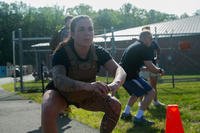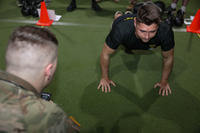This article is part two of the three-part series on 20 Pull-ups for Women:
1. How to get your first pull-up
2. Getting the USMC women's maximum (eight reps; this article)
3. Getting the USMC male maximum (20 reps)
Adding pull-up repetitions -- turning pull-ups into an endurance exercise (aka adding repetitions)
After you have reached the first and toughest hurdle of this journey --the first pull-up -- this step is easy comparatively. The basic training principles for how to succeed at pull-ups are the same as in the How to Get Your First Pull-up article -- practice pull-ups often -- but now we add another step to the equation to help you build up your endurance (muscle stamina).
As mentioned in the previous article, physical trainers have learned the best method to get better at a particular exercise is to perform the actual exercise often. Where trainers sometimes disagree is the level of intensity required for maximum results.
For example, some trainers teach to push your perceived limits in an exercise to do more repetitions. In other words, they teach to push yourself to the point of failure several times during your workout, every other day (three days/week).
Other trainers recommend not pushing yourself to failure. They recommend executing several "sub-max effort" sets throughout the day, multiple days of the week (4-5 days/week). The idea is that by doing frequent, non-exhaustive sets of a specific exercise, muscles gradually get more efficient at the movement. During the process of becoming more efficient, it becomes easier for a person's muscles to repeat that movement.
Since the "train to failure" and "moderate intensity" schools of thought have merit, why not use a combination of both to optimize training? For example, pushing your max effort is essential to getting to the next level, but it does not have to be done 100% of the time.
Matter of fact, it should not be done 100% of the time. You especially do not want to do "failure sets" on back-to-back pull-up workout days. You must place an extra recovery day between future pull-up workouts and not go to failure on every set, every day that you do pull-ups.
In other words, do max-effort sets only once per week with two rest days afterward. On subsequent pull-up workout days, do several "sub-max" effort sets. In this manner, a combination of both methods done every other day of the week is optimal.
Note: I have seen people progress nicely in pull-ups, using many methods. But the true similarity of success in pull-ups is consistency. Practice pull-ups at least three days a week, regardless of the method you choose.
How to do it: Now that you are able to do at least one unassisted pull-up, combine sets of unassisted pull-ups with an easier version of the pull-up to work the same movement and muscle groups for extra repetitions, which are required to spur growth and achieve muscle endurance.
The following is a sample workout to get to 8-10 pull-ups:
|
Monday |
Wednesday |
Saturday |
|
Max endurance sets -- Pull-ups/progressions plus weights and dumbbells at sub-max effort (moderate intensity): Build your endurance with this workout. Shoot for 50-100 total repetitions during your workout by combining unassisted pull-ups, partial ROM pull-ups, assisted pull-ups, negatives, weighted negatives, jumping pull-ups, pull-downs, biceps curls, etc. Select at least 4-5 pull-up progression exercises and perform them (in addition to unassisted pull-ups) until your total pulling repetitions reaches 50-100 reps in a workout. Do not go to failure; stop each set a few reps short of failure to maximize volume. Rest exercise between pull-up sets: Select push-ups, planks, crunches, etc., to work the core and pushing balance muscles. Follow workout with a run or ruck distance of your choice/capability. |
Max-Rep failure sets Repeat 4-5 times. Max pull-ups, plus one rep failure (perform unassisted pull-ups until you no longer can hang on the bar or pull yourself up). Drop from the bar and follow with max-effort negatives, pull-downs, rows, etc., to build up your repetitions for that set Rest exercise between pull-up sets: Select running, squats, lunges, push-ups, abs, lower back (calisthenics or weight). Follow workout with run, ruck or swim, or combination of the three options. |
Pyramid workout: Use a combination of unassisted pull-ups and assisted pull-ups (upon failing) to complete the required quantity of pull-ups for each set: Using the PT Pyramid: Reps increase, then decrease with each set of pull-ups, push-ups, sit-ups/crunches. Always try to get the first few reps doing unassisted pull-ups, then resort to the next easier version of the pull-up progression list until you get the required quantity of reps in each set. Follow workout with run, ruck or swim, or combination of the three options. |
As you can see, when making the pull-up an endurance exercise, pull-down and pull-up assist machines are not totally useless. Even though they should not be used as the primary means for working the pull-up movement pattern, they certainly have their place in a strength/muscle stamina training routine. So do other auxiliary exercises (lat pulldowns, push-ups, etc.) that work the pull-up muscles (back, biceps, lats, shoulders, grip, etc.).
In other words, strength training is good for its own sake, but it should augment and not replace exercising on a pull-up bar. Similarly, pull-ups are a phenomenal dynamic strength exercise, but your strength training routine should not consist of only pull-ups.
The Exercises PLUS NEW Supplemental Exercises (video description)
As discussed in Article #1, the following exercises still are part of your workout:
In order of easiest to hardest options:
Do as many unassisted pull-ups as you can. When you fail, continue with the pull-up progression that challenges you the most.
Start in this order: Follow a failed pull-up rep with a few of the following pull-up progressions that challenge you the most:
Partial ROM pull-ups: Try half pull-ups. Halfway down/back up. All the way down/halfway up.
Partner/equipment assist: Have a spotter push you when you no longer can pull yourself up, then lower yourself slowly. If using a band, chair or bench, use only the minimum required amount of assistance to propel yourself to the up position, then lower yourself slowly for 4-5 seconds.
Jumping pull-ups: Drop off the bar after a four- to five-second negative and try to get back to the up position by jumping/pulling yourself.
Pausing negatives: Stop your downward movement for 4-5 seconds a quarter, half or three-quarters of the way down.
Weighted negatives: Add 5-10 pounds, get into the up position, then lower yourself slowly for 4-5 seconds.
L-sit negatives: Once you are in the up position, lift your legs so they are parallel to the deck (or as high as you can get them), then lower yourself slowly for 4-5 seconds.
Negatives: Get into the up position, then lower yourself slowly for 4-5 seconds.
After you have failed with the above pull-up progression exercises, continue with the below list of weighted options and dumbbells during your workout:
Dead hangs: Grasp the bar with your desired grip, activate the shoulders and hang on the bar until failure (or for a predetermined amount of time).
L-Sits: Grasp the bar with your desired grip, activate the shoulders, lift legs until they are parallel to the deck (or as high as you can go) and hang on the bar until failure (or for a predetermined amount of time).
Pulldowns or Gravitron (pull-up assist) Machine: Pick a heavy weight close to your body weight and aim for 4-5 repetitions.
Dumbbell rows: Pick a heavy weight and aim for 4-5 repetitions each arm.
Biceps curls: You can top off each pull-up set with a final few reps of biceps curls of moderate weight for 5-10 repetitions.
In addition to the above exercises, do not forget to work other muscle groups while you "rest" your pull-up muscles. Run and do squats, lunges, flutter kicks, push-ups, shoulder presses and dips in order to work the other muscle groups of the body that are required in your profession.
Don't just focus on your pulling muscles to ace the test. These other muscle-group exercises make great "resting" exercises between multiple pull-up sets and help create a well-rounded, full-body workout routine.
Stew Smith is a former Navy SEAL and fitness author certified as a Strength and Conditioning Specialist (CSCS) with the National Strength and Conditioning Association. Visit his Fitness eBook store if you're looking to start a workout program to create a healthy lifestyle. Send your fitness questions to stew@stewsmith.com.
Want to Learn More About Military Life?
Whether you're thinking of joining the military, looking for fitness and basic training tips, or keeping up with military life and benefits, Military.com has you covered. Subscribe to Military.com to have military news, updates and resources delivered directly to your inbox.



















